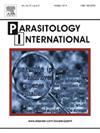Evaluating the vector potential of deer keds Lipoptena fortisetosa for selected pathogens in Hokkaido sika deer (Cervus nippon yesoensis)
IF 1.9
4区 医学
Q3 PARASITOLOGY
引用次数: 0
Abstract
Deer keds (Lipoptena fortisetosa) are hematophagous insects that parasitize various ungulates, including Hokkaido sika deer (Cervus nippon yesoensis). Although deer keds are potential vectors for several pathogens, their role in disease transmission in Japan remains unclear. This study aimed to evaluate the potential of L. fortisetosa as a vector for selected pathogens in sika deer. Blood samples were collected from 32 sika deer and 149 deer keds (64 from deer and 85 from the environment) from the Rusha area of the Shiretoko Peninsula, Hokkaido, Japan. Nested PCRs and sequencing were performed to detect 18S rRNA gene of Theileria sp. Thrivae, 16S rRNA gene of Anaplasma sp. AP-sd (AP-sd), and flagellin B gene of Borrelia sp. in deer and deer keds. In sika deer, the infection rate was 84 % for Theileria sp. Thrivae, 75 % of AP-sd, and 3 % of Borrelia sp. The prevalence in deer keds collected from deer was 62 % for Theileria sp. Thrivae, 2 % AP-sd, and 1 % Borrelia sp. No pathogens were detected in nonparasitic deer keds captured from the environment. Notably, Theileria sp. Thrivae and AP-sd were detected in deer keds collected from PCR-negative sika deer, suggesting that deer keds acquired pathogens from a previously infested host. The absence of pathogens in non-parasitized deer keds suggests that they do not play as a biological vector for the tested pathogens. This study suggests a potential role for L. fortisetosa as a mechanical vector, emphasizing the need for additional experiments, including infection studies.

鹿瘟对北海道梅花鹿致病菌传病潜力的评价。
鹿蛉(Lipoptena fortisetosa)是寄生在各种有蹄类动物身上的食血昆虫,包括北海道梅花鹿(Cervus nippon yesoensis)。虽然鹿是几种病原体的潜在媒介,但它们在日本疾病传播中的作用尚不清楚。本研究的目的是评价该菌作为梅花鹿致病菌传播媒介的潜力。采集了来自日本北海道知子半岛芦沙地区32只梅花鹿和149只鹿(64只鹿,85只环境)的血液样本。采用巢式pcr和测序技术,检测了鹿和鹿幼体中Thrivae氏芽孢杆菌(Theileria sp. Thrivae)的18S rRNA基因、无原体sp. AP-sd (AP-sd)的16S rRNA基因和伯氏螺旋体sp.鞭毛蛋白B基因。梅花鹿的幼虫感染率为84 %,AP-sd感染率为75 %,伯氏疏螺旋体感染率为3 %。采集鹿的幼虫感染率为62 %,AP-sd感染率为2 %,伯氏疏螺旋体感染率为1 %。从环境中捕获的非寄生鹿的幼虫未检出病原体。值得注意的是,从pcr阴性梅花鹿采集的鹿仔中检测到他们的幼虫和AP-sd,这表明鹿仔从先前感染的宿主那里获得了病原体。未被寄生的鹿仔中没有病原体,这表明它们不是被检测病原体的生物媒介。该研究提示了L. fortisetosa作为机械媒介的潜在作用,强调需要进行更多的实验,包括感染研究。
本文章由计算机程序翻译,如有差异,请以英文原文为准。
求助全文
约1分钟内获得全文
求助全文
来源期刊

Parasitology International
医学-寄生虫学
CiteScore
4.00
自引率
10.50%
发文量
140
审稿时长
61 days
期刊介绍:
Parasitology International provides a medium for rapid, carefully reviewed publications in the field of human and animal parasitology. Original papers, rapid communications, and original case reports from all geographical areas and covering all parasitological disciplines, including structure, immunology, cell biology, biochemistry, molecular biology, and systematics, may be submitted. Reviews on recent developments are invited regularly, but suggestions in this respect are welcome. Letters to the Editor commenting on any aspect of the Journal are also welcome.
 求助内容:
求助内容: 应助结果提醒方式:
应助结果提醒方式:


